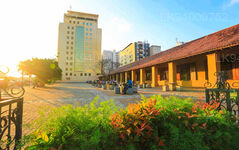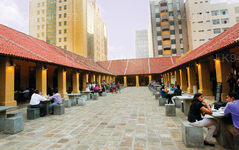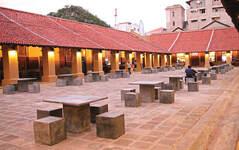
Colombo City
Colombo, the capital of Sri Lanka, is a dynamic city blending tradition and modernity. It showcases colonial architecture, lively markets, and serene Buddhist temples. With diverse cuisine, a growing skyline, and beautiful beaches, it's a vibrant hub for business, culture, and tourism, offering a gateway to explore Sri Lanka's wonders.
Old Colombo Dutch Hospital
Amongst the busy commercial trade zone of the Colombo Fort region in Sri Lanka are some of the oldest structures of the city. The Old Dutch Hospital with its tropical colonial-era architecture is one of them. The old structure; with its boxy pillars, red clay roof tiles and large central courtyards; was built in the late 17th century by the Dutch. They were influenced by the tropical requirements and the local building style in Ceylon at the time, as is evidenced by the design; which is quite different from European structures of the era. While the building may seem comparatively dull overall; it’s important to feel the echoes of its hstory while visiting.
History
The building was initially designed as a hospital for the soldiers and personnel of the Dutch East India Company.
The hospital’s close proximity to the harbor also allowed it to serve Dutch seafarers. Paintings from the era show that there was once had a canal running next to the hospital, along what is now Canal Row lane. This canal was filled in by British colonists after their capture of the city.
When it came to facilities; the Dutch Hospital was what could be called ‘top-end’ for the time. There were no beds provided there, as proper beds were not available in Ceylon at the time. Instead, most patients were provided with a reed mat; while the most critically ill or the most affluential personalities were given a straw mattress, which was a luxury in the era. The patients clothing was imported from Thoothukudi (also known as Tuticorin by the Dutch at the time) state in India.
Alleman was the surgeon with the longest service at the hospital; and it has been recorded that he worked hard to improve the conditions at the hospital, including increasing provisions. However, the most famous surgeon to have worked at the Colombo Dutch Hospital was definitely Paul Hermann, who served from 1672 to 1679. Herman has been described as the father of botany in Sri Lanka. He brought about an evolution to Sri Lanka’s medical scene. However, when the British took over from the Dutch, the hospital lost its popularity and was not used any more.
After Sri Lanka received independence, the then empty hospital building was used for a variety of purposes. It was the Colombo Fort Police Station from the early 1980s to 1990s, prior to which it housed the Colombo Apothecaries. It suffered some damage during the Civil War of the late 20th century and was subsequently abandoned.
It was in 2011 that the Old Dutch Hospital premises underwent a transformation. The entire structure was renovated to its original glory and converted into a shopping and dining arcade.
The Architecture
The Dutch Hospital has five wings and two central courtyards. The wide eaves were designed to be shady and cool; while the entire building was made to provide a comfortable internal environment. Like many Sri Lankan Dutch buildings of the era; the walls are half a meter thick, while the rafters are made of massive teak beams. The upper floor has a wooden floor and can be reached using a wooded staircase in the front wing. In addition, long open veranda runs along the length of each wing of the building.
Paintings of the front and rear views of the Colombo Dutch Hospital, done in 1771 by a Dutch artist, are preserved in the Royal Netherlands Institute of Southeast Asian and Caribbean Studies, in the Netherlands. These show that though the facade of the building hasn’t changed much, the original landscaping has completely disappeared.
The Arcade
The restaurants and stores within the Old Dutch Hospital tend to be more on the high end and expensive. Some of the places worth visiting there are The Ministry of the Crab, with its mouthwatering crab cuisine; Barefoot Gallery Cafe with its colorful handloom fabric clothing, stuffed toys and etc; Spa Ceylon with its fragrant herbal bath and body therapy items, and the Heladiv Tea Club with its delicious teas, cakes and sandwiches. There are also a number of other good stores that open up suddenly in spare spaces, which are worth having a look at.
About Colombo District
Colombo is the largest city and commercial capital of Sri Lanka. It is located on the west coast of the island and adjacent to Sri Jayewardenepura Kotte, the capital city of Sri Lanka. Colombo is a busy and vibrant city with a mixture of modern life and colonial buildings and ruins and a city population of 647,100.The Colombo Metropolitan Region, defined by the districts of Colombo, Gampaha and Kalutara, has an estimated population of 5,648,000, and covers an area of 3,694.20 km²
Colombo is a multi-ethnic, multi-cultural city. It is the most populous city in Sri Lanka, with 642,163 people living within the city limits. The population of Colombo is a mix of numerous ethnic groups, mainly Sinhalese, Moors and Tamils. There are also small communities of people with Chinese, Portuguese, Dutch, Malay and Indian origins living in the city, as well as numerous European expatriates.
The great majority of Sri Lankan corporations have their head offices in Colombo. Some of the industries include chemicals, textiles, glass, cement, leather goods, furniture, and jewellery. In the city center is located South Asia's second tallest building - The World Trade Centre.
About Western Province
The Western Province is the most densely populated province of Sri Lanka. It is home to the legislative capital Sri Jayawardenepura Kotte as well to Colombo, the nation's administrative and business center. Western Province is divided into 3 main districts called Colombo (642 km²), Gampaha (1,386.6 km²) and Kalutara (1,606 km²) districts. As Sri Lanka's economic hub, all the major local and international corporations have their presence in the city and so do all the major designer and high street retailers, so be ready to indulge in some retail therapy in western province.
Having the highest population in the all the provinces, the almost all the premier educational institutions in the island are located in western province. Universities in the province include the University of Colombo, the University of Sri Jayewardenepura, University of Kelaniya, Open University, Sri Lanka, Buddhist and Pali University of Sri Lanka, General Sir John Kotelawala Defence University and University of Moratuwa .Western province has the largest amount of schools in the country, which includes National, Provincial, Private and International schools.







































